- April 2018
- March 2018
- February 2018
- January 2018
- December 2017
- November 2017
- October 2017
- September 2017
- August 2017
- July 2017
- June 2017
- May 2017
- April 2017
- March 2017
- February 2017
- January 2017
- 2017
- 2016
- 2015
- 2014
- 2013
News : December 2016
Commemorative Stamps on Legendary Singers of India – 30th December 2016.
Department of Posts released a set of ten commemorative stamps and a miniature sheet on Talat Mahmood, Manna Dey, Mohammed Rafi, Kishore Kumar, Mukesh, Hemant Kumar, Bhupen Hazarika, Geeta Dutt, T. M. Soundarajrajan and Shamshad Begum under Legendary Singers series on 30th December 2016.
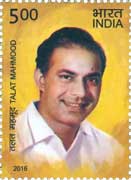 Talat Mahmood (February 1924 – 9 May 1998) is considered one of the greatest male singers in India. A born singer with an intuitive sense of beauty, charm and grace; a legendary Indian playback singer who created his own new style of ghazal singing which was to be followed afterwards. Talat Mahmood received Padma Bhushan in 1992, in recognition of his artistic contributions in the spheres of cinematic and ghazal music.
Talat Mahmood (February 1924 – 9 May 1998) is considered one of the greatest male singers in India. A born singer with an intuitive sense of beauty, charm and grace; a legendary Indian playback singer who created his own new style of ghazal singing which was to be followed afterwards. Talat Mahmood received Padma Bhushan in 1992, in recognition of his artistic contributions in the spheres of cinematic and ghazal music.
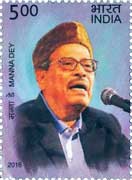 Prabodh Chandra Dey (1 May 1919 − 24 October 2013), known by his stage name Manna Dey, was a playback singer. He debuted in the film Tamanna in 1942, by this song "Upar Gagan Bishal" and went on to record more than 4,000 songs from 1942 to 2013. The Government of India honoured him with the Padma Shri in 1971, the Padma Bhushan in 2005 and the Dadasaheb Phalke Award in 2007. Manna Dey sang in all the major regional Indian languages, though primarily in Hindi and Bengali. His peak period in Hindi playback singing was from 1953 to 1976.
Prabodh Chandra Dey (1 May 1919 − 24 October 2013), known by his stage name Manna Dey, was a playback singer. He debuted in the film Tamanna in 1942, by this song "Upar Gagan Bishal" and went on to record more than 4,000 songs from 1942 to 2013. The Government of India honoured him with the Padma Shri in 1971, the Padma Bhushan in 2005 and the Dadasaheb Phalke Award in 2007. Manna Dey sang in all the major regional Indian languages, though primarily in Hindi and Bengali. His peak period in Hindi playback singing was from 1953 to 1976.
 Mohammed Rafi (24 December 1924 – 31 July 1980) was one of the most popular singers of the Hindi film industry. Rafi was notable for his versatility; his songs ranged from classical numbers to patriotic songs, sad lamentations to highly romantic numbers, qawwalis to ghazals and bhajans. He was known for his ability to mould his voice to the persona of the actor, lip-synching the song on screen in the movie. Between 1950 and 1970, Rafi was the most sought after singer in the Hindi film industry. He received six Filmfare Awards and one National Film Award. In 1967, he was honoured with the Padma Shri award by the Government of India. Rafi is primarily noted for his songs in Hindi, over which he had a strong command. It is believed that he sang about 7,400 songs in many languages. He sang in other Indian languages including Assamese, Konkani, Bhojpuri, Odia, Punjabi, Bengali, Marathi, Sindhi, Kannada, Gujarati, Telugu, Magahi, Maithili and Urdu. Apart from Indian languages, he also sang songs in English, Farsi, Arabic, Sinhalese, Creole and Dutch.
Mohammed Rafi (24 December 1924 – 31 July 1980) was one of the most popular singers of the Hindi film industry. Rafi was notable for his versatility; his songs ranged from classical numbers to patriotic songs, sad lamentations to highly romantic numbers, qawwalis to ghazals and bhajans. He was known for his ability to mould his voice to the persona of the actor, lip-synching the song on screen in the movie. Between 1950 and 1970, Rafi was the most sought after singer in the Hindi film industry. He received six Filmfare Awards and one National Film Award. In 1967, he was honoured with the Padma Shri award by the Government of India. Rafi is primarily noted for his songs in Hindi, over which he had a strong command. It is believed that he sang about 7,400 songs in many languages. He sang in other Indian languages including Assamese, Konkani, Bhojpuri, Odia, Punjabi, Bengali, Marathi, Sindhi, Kannada, Gujarati, Telugu, Magahi, Maithili and Urdu. Apart from Indian languages, he also sang songs in English, Farsi, Arabic, Sinhalese, Creole and Dutch.
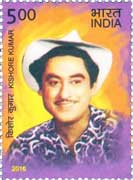 Kishore Kumar (4 August 1929 – 13 October 1987) was a famous playback singer, actor, lyricist, composer, producer, director and screenwriter. He is considered one of the most successful playback singers of the Hindi film industry. Apart from Hindi, he sang in many Indian languages including Bengali, Marathi, Assamese, Gujarati, Kannada, Bhojpuri, Malayalam, Odia, and Urdu. He has also sung in private albums in several languages especially in Bengali which are noted as all-time classics. He won 8 Filmfare Awards for Best Male Playback Singer and holds the record for winning the most Filmfare Awards in that category. He was awarded the "Lata Mangeshkar Award" by the Madhya Pradesh government and from that year onwards, the Madhya Pradesh Government initiated a new award called the "Kishore Kumar Award" for contributions to Hindi cinema.
Kishore Kumar (4 August 1929 – 13 October 1987) was a famous playback singer, actor, lyricist, composer, producer, director and screenwriter. He is considered one of the most successful playback singers of the Hindi film industry. Apart from Hindi, he sang in many Indian languages including Bengali, Marathi, Assamese, Gujarati, Kannada, Bhojpuri, Malayalam, Odia, and Urdu. He has also sung in private albums in several languages especially in Bengali which are noted as all-time classics. He won 8 Filmfare Awards for Best Male Playback Singer and holds the record for winning the most Filmfare Awards in that category. He was awarded the "Lata Mangeshkar Award" by the Madhya Pradesh government and from that year onwards, the Madhya Pradesh Government initiated a new award called the "Kishore Kumar Award" for contributions to Hindi cinema.
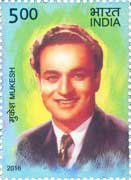 Mukesh Chand Mathur (22 July 1923 – 27 August 1976), better known mononymously as Mukesh, was a playback singer of Hindi movies. Along with Mohammad Rafi, Manna Dey and Kishore Kumar, he was one of the most popular and legendary singer of his era. Amongst the numerous nominations and awards he won, his song "Kai Baar Yuhi Dekha Hai" from film Rajnigandha (1973) won him the National Film Award for Best Male Playback Singer. Mukesh was also popular as being the voice of the actor Raj Kapoor. Mukesh's voice was first noticed by Motilal, a distant relative, when he sang at his sister's wedding. Motilal took him to Mumbai and arranged for singing lessons by Pandit Jagannath Prasad. During this period Mukesh was offered a role as an actor-singer in a Hindi film, Nirdosh (1941). His first song was "Dil Hi Bujha Hua Ho To" as an actor-singer for Nirdosh. He got his break as a playback singer for actor Motilal in 1945 with the film Pehli Nazar with music composed by Anil Biswas and lyrics written by Aah Sitapuri. The first song that he sang for a Hindi film was "Dil Jalta Hai To Jalne De".
Mukesh Chand Mathur (22 July 1923 – 27 August 1976), better known mononymously as Mukesh, was a playback singer of Hindi movies. Along with Mohammad Rafi, Manna Dey and Kishore Kumar, he was one of the most popular and legendary singer of his era. Amongst the numerous nominations and awards he won, his song "Kai Baar Yuhi Dekha Hai" from film Rajnigandha (1973) won him the National Film Award for Best Male Playback Singer. Mukesh was also popular as being the voice of the actor Raj Kapoor. Mukesh's voice was first noticed by Motilal, a distant relative, when he sang at his sister's wedding. Motilal took him to Mumbai and arranged for singing lessons by Pandit Jagannath Prasad. During this period Mukesh was offered a role as an actor-singer in a Hindi film, Nirdosh (1941). His first song was "Dil Hi Bujha Hua Ho To" as an actor-singer for Nirdosh. He got his break as a playback singer for actor Motilal in 1945 with the film Pehli Nazar with music composed by Anil Biswas and lyrics written by Aah Sitapuri. The first song that he sang for a Hindi film was "Dil Jalta Hai To Jalne De".
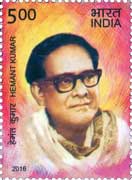 Hemanta Mukherjee, often credited as Hemant Kumar (16 June 1920 – 26 September 1989), was a playback singer, music director and film producer, who sang in Bengali, Hindi and other Indian languages. He won two National awards for the category best male playback singer. Hemanta was born in the city of Varanasi, India. His family originated from Baharu village in West Bengal. They migrated to Kolkata in the early 1900s. Hemanta grew up there and attended Nasiruddin School and later Mitra Institution school of Bhawanipore area. There he met his longtime friend Subhas Mukhopadhyay who later became a Bengali poet. During this time, he developed a friendship with the noted writer Santosh Kumar Ghosh. At that time, Hemanta wrote short stories, Santosh Kumar wrote poems and Subhash Mukhopadhyay sang songs.
Hemanta Mukherjee, often credited as Hemant Kumar (16 June 1920 – 26 September 1989), was a playback singer, music director and film producer, who sang in Bengali, Hindi and other Indian languages. He won two National awards for the category best male playback singer. Hemanta was born in the city of Varanasi, India. His family originated from Baharu village in West Bengal. They migrated to Kolkata in the early 1900s. Hemanta grew up there and attended Nasiruddin School and later Mitra Institution school of Bhawanipore area. There he met his longtime friend Subhas Mukhopadhyay who later became a Bengali poet. During this time, he developed a friendship with the noted writer Santosh Kumar Ghosh. At that time, Hemanta wrote short stories, Santosh Kumar wrote poems and Subhash Mukhopadhyay sang songs.
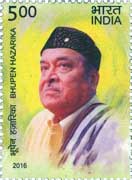 Bhupen Hazarika (1926–2011) was a lyricist, musician, singer, poet and film-maker from Assam, widely known as Sudhakantha. His songs, written and sung mainly in the Assamese language by himself, are marked by humanity and universal brotherhood and have been translated and sung in many languages, most notably in Bengali and Hindi. His songs, based on the themes of communal amity, universal justice and empathy, have become popular among the people of Assam, besides West Bengal and Bangladesh. He is also acknowledged to have introduced the culture and folk music of Assam and Northeast India to Hindi cinema at the national level. He received the National Film Award for Best Music Direction in 1975. Recipient of Sangeet Natak Akademi Award (1987), Padmashri (1997), and Padmabhushan (2001), Hazarika was awarded with Dada Saheb Phalke Award (1992), India's highest award in cinema, by the Government of India and Sangeet Natak Akademi Fellowship (2008), the highest award of the Sangeet Natak Akademi, India's The National Academy for Music, Dance and Drama. He was posthumously awarded the Padma Vibhushan, India's second-highest civilian award, in 2012. Hazarika also held the position of the Chairman of the Sangeet Natak Akademi from December 1998 to December 2003.
Bhupen Hazarika (1926–2011) was a lyricist, musician, singer, poet and film-maker from Assam, widely known as Sudhakantha. His songs, written and sung mainly in the Assamese language by himself, are marked by humanity and universal brotherhood and have been translated and sung in many languages, most notably in Bengali and Hindi. His songs, based on the themes of communal amity, universal justice and empathy, have become popular among the people of Assam, besides West Bengal and Bangladesh. He is also acknowledged to have introduced the culture and folk music of Assam and Northeast India to Hindi cinema at the national level. He received the National Film Award for Best Music Direction in 1975. Recipient of Sangeet Natak Akademi Award (1987), Padmashri (1997), and Padmabhushan (2001), Hazarika was awarded with Dada Saheb Phalke Award (1992), India's highest award in cinema, by the Government of India and Sangeet Natak Akademi Fellowship (2008), the highest award of the Sangeet Natak Akademi, India's The National Academy for Music, Dance and Drama. He was posthumously awarded the Padma Vibhushan, India's second-highest civilian award, in 2012. Hazarika also held the position of the Chairman of the Sangeet Natak Akademi from December 1998 to December 2003.
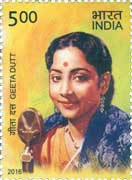 Geeta Dutt (born Geetā Ghosh Roy Chowdhuri; 23 November 1930 – 20 July 1972 was a prominent singer, born in Faridpur before the Partition of India. She found particular prominence as a playback singer in Hindi cinema. She also sang many modern Bengali songs, both in film and non-film genre. Geeta Ghosh Roy Chowdhuri was one of 10 children born to a wealthy Zamindar family in a village named Idilpur, presently under Gosairhat Upzilla of Shariatpur District, Bangladesh, formerly under Faridpur district in Bengal, British India. Her family moved to Calcutta and Assam in the early forties, leaving behind their land and properties. In 1942, her parents moved to an apartment in Bombay. Geeta was twelve and continued her schooling at the Bengali High School.
Geeta Dutt (born Geetā Ghosh Roy Chowdhuri; 23 November 1930 – 20 July 1972 was a prominent singer, born in Faridpur before the Partition of India. She found particular prominence as a playback singer in Hindi cinema. She also sang many modern Bengali songs, both in film and non-film genre. Geeta Ghosh Roy Chowdhuri was one of 10 children born to a wealthy Zamindar family in a village named Idilpur, presently under Gosairhat Upzilla of Shariatpur District, Bangladesh, formerly under Faridpur district in Bengal, British India. Her family moved to Calcutta and Assam in the early forties, leaving behind their land and properties. In 1942, her parents moved to an apartment in Bombay. Geeta was twelve and continued her schooling at the Bengali High School.
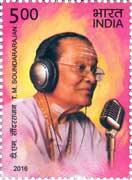 Thoguluva Meenatchi Iyengar Soundararajan (24 March 1922 – 25 May 2013), popularly known as TMS, was a playback singer in Kollywood for over six decades. He gave his voice to actors and thespians in the South Indian film industry such as M. G. Ramachandran, Sivaji Ganesan, N. T. Rama Rao, Gemini Ganesan, S. S. Rajendran, Jaishankar, Ravichandar, AVM Rajan, Muthuraman, Nagesh, Rajkumar and A. Nageswara Rao. He also gave his voice to many new generation actors like Kamalahasan, Rajanikanth, Vijayakanth, Satyaraj, Rajesh, Prabhu, Vijaya Kumar and in five generation actors. He has sung over 20,000 film songs from more than 5,000 films. He has sung over 3,000 devotionals classical songs. He has also given classical concerts since 1945. In a career spanning over 6 decades he has recorded film songs in eleven languages including, Tamil, Kannada, Telugu, Hindi, Malayalam and other Indian languages. He also composed music for many of the ever-green devotional songs that were recorded. He was the music director for the film "Bala Parikshai". His peak period as a male playback singer in the South Indian film industry was from 1955 to 1985. Soundararajan died on 25 May 2013 at his residence in Mandaveli, Chennai due to illness. He was 91 years old at the time of his death.
Thoguluva Meenatchi Iyengar Soundararajan (24 March 1922 – 25 May 2013), popularly known as TMS, was a playback singer in Kollywood for over six decades. He gave his voice to actors and thespians in the South Indian film industry such as M. G. Ramachandran, Sivaji Ganesan, N. T. Rama Rao, Gemini Ganesan, S. S. Rajendran, Jaishankar, Ravichandar, AVM Rajan, Muthuraman, Nagesh, Rajkumar and A. Nageswara Rao. He also gave his voice to many new generation actors like Kamalahasan, Rajanikanth, Vijayakanth, Satyaraj, Rajesh, Prabhu, Vijaya Kumar and in five generation actors. He has sung over 20,000 film songs from more than 5,000 films. He has sung over 3,000 devotionals classical songs. He has also given classical concerts since 1945. In a career spanning over 6 decades he has recorded film songs in eleven languages including, Tamil, Kannada, Telugu, Hindi, Malayalam and other Indian languages. He also composed music for many of the ever-green devotional songs that were recorded. He was the music director for the film "Bala Parikshai". His peak period as a male playback singer in the South Indian film industry was from 1955 to 1985. Soundararajan died on 25 May 2013 at his residence in Mandaveli, Chennai due to illness. He was 91 years old at the time of his death.
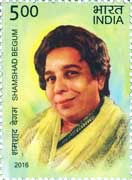 Shamshad Begum (14 April 1919 – 23 April 2013) was an Indian singer who was one of the first playback singers in the Hindi film industry. She had a distinctive voice and was a versatile artist, singing over 6,000 songs in Hindi and the Bengali, Marathi, Gujarati, Tamil and Punjabi languages and of them 1287 songs were Hindi film songs. She worked with maestros including Naushad Ali, S. D. Burman, C. Ramchandra and O. P. Nayyar. Her songs from the 1940s to the early 1970s remain popular and continue to be remixed. She was born in Lahore of modern day Pakistan on 14 April 1919, the day after the Jallianwala Bagh massacre took place in nearby Amritsar city. She was one of eight children, five sons and three daughters, born to a conservative Muslim family of limited means. Her father, Mian Hussain Baksh Maan, worked as a mechanic, and her mother, Ghulam Fatima, was a pious lady of conservative disposition, a devoted wife and mother who raised her children with traditional family values.
Shamshad Begum (14 April 1919 – 23 April 2013) was an Indian singer who was one of the first playback singers in the Hindi film industry. She had a distinctive voice and was a versatile artist, singing over 6,000 songs in Hindi and the Bengali, Marathi, Gujarati, Tamil and Punjabi languages and of them 1287 songs were Hindi film songs. She worked with maestros including Naushad Ali, S. D. Burman, C. Ramchandra and O. P. Nayyar. Her songs from the 1940s to the early 1970s remain popular and continue to be remixed. She was born in Lahore of modern day Pakistan on 14 April 1919, the day after the Jallianwala Bagh massacre took place in nearby Amritsar city. She was one of eight children, five sons and three daughters, born to a conservative Muslim family of limited means. Her father, Mian Hussain Baksh Maan, worked as a mechanic, and her mother, Ghulam Fatima, was a pious lady of conservative disposition, a devoted wife and mother who raised her children with traditional family values.

Commemorative Stamp on Pandit Deendayal Upadhyay - 29th December 2016.
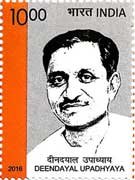 Pandit Deendayal Upadhyay (25 September 1916 – 11 February 1968) was an Indian philosopher, economist, sociologist, historian, journalist, and political scientist. He was one of the most important leaders of the Bharatiya Jana Sangh, the forerunner of the present day Bharatiya Janata Party. He was born in the village Chandrabhan, now called Deendayal Dham, near the Farah town in Mathura District, 26 km away from Mathura. His father, Bhagwati Prasad, was a well-known astrologer and his mother Shrimati Rampyari was a religious-minded lady. Deendayal Upadhyaya was a man of soaring idealism and had a tremendous capacity for organisation and reflected different aspects of a social thinker, economist, educationalist, politician, writer, journalist, speaker, organiser etc. He was regarded as an ideal swayamsevak of the RSS essentially because ‘his discourse reflected the pure thought-current of the Sangh’. Upadhyaya conceived the political philosophy Integral Humanism – the guiding philosophy of the Bharatiya Janata Party. The philosophy of Integral Humanism advocates the simultaneous and integrated program of the body, mind and intellect and soul of each human being.
Pandit Deendayal Upadhyay (25 September 1916 – 11 February 1968) was an Indian philosopher, economist, sociologist, historian, journalist, and political scientist. He was one of the most important leaders of the Bharatiya Jana Sangh, the forerunner of the present day Bharatiya Janata Party. He was born in the village Chandrabhan, now called Deendayal Dham, near the Farah town in Mathura District, 26 km away from Mathura. His father, Bhagwati Prasad, was a well-known astrologer and his mother Shrimati Rampyari was a religious-minded lady. Deendayal Upadhyaya was a man of soaring idealism and had a tremendous capacity for organisation and reflected different aspects of a social thinker, economist, educationalist, politician, writer, journalist, speaker, organiser etc. He was regarded as an ideal swayamsevak of the RSS essentially because ‘his discourse reflected the pure thought-current of the Sangh’. Upadhyaya conceived the political philosophy Integral Humanism – the guiding philosophy of the Bharatiya Janata Party. The philosophy of Integral Humanism advocates the simultaneous and integrated program of the body, mind and intellect and soul of each human being.
Commemorative Stamp on Pandit Deendayal Upadhyay was released by Uttar Pradesh Governor Shri Ram Naik and President of the Bharatiya Janata Party Shri Amit Shah at Lucknow on 29th December 2016.
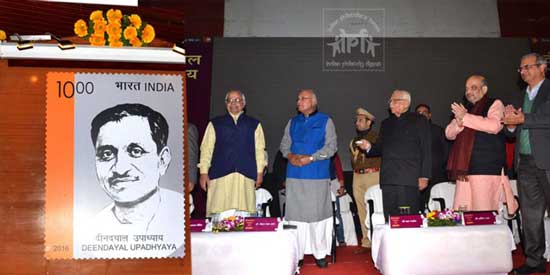
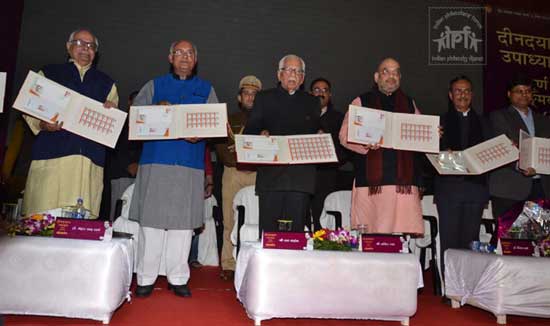
Special Cover on Dr. Gaya Prasad Katiyar - 26th December 2016.
Dr. Gaya Prasad Katiyar was one of the most dedicated soldiers of India’s freedom struggle. Gaya Prasad Katiyar was born at Jagadishpur (UP). He joined Hindustan Socialist Republican Association in 1925 and got connected with Chandra Shekhar Azad and Bhagat Singh. Later he participated on Lahore Conspiracy Case and was arrested from Saharanpur in 1929. He joined the hunger strike at Lahore Jail with his co prisoners. Later he was transported to Cellular jail in Andaman and again he participated on hunger strike there. He was repatriated in 1937 but again arrested and transported to cellular jail from where he was released in 1946.
Department of Posts released a Special Cover on Dr. Gaya Prasad Katiyar on 26th December 2016 at the function held to release commemorative stamps on Personalities of Bihar at New Delhi by Smt Anupriya Patel, Minister of State for Health & Family Welfare in presence of Mr. B. V. Sudhakar, Secretary, Department of Posts & Chairperson, Postal Services Board, Shri A. N. Nanda, Member (Banking & HRD) and Hardayal Municipal Public Library Chairperson Shobha Vijender.
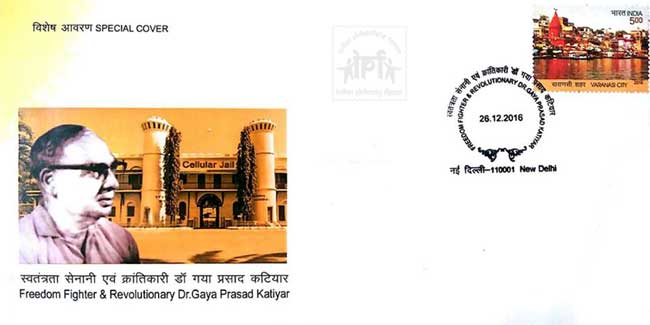
Commemorative Stamp on Hardayal Municipal Heritage Public Library – 26th December 2016.
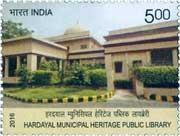 Hardayal Municipal Public Library is situated in the heart of Chandni Chowk and is one of the very few oldest buildings that have been able to withstand the onslaught of modern times. The library was set up in 1862 as a part of a reading club for Englishmen. The books were given to the reading room, called the Institute Library, which was part of the Lawrence Institute, named after the then Viceroy of India. In 1902, the library was renamed Delhi Public Library.Delhi Public Library was renamed Hardinge Municipal Library in 1916. In 1970, Hardinge Library became Hardayal Library. It has a unique collection of more than 1,70,000 books in Hindi, English, Urdu, Arabic, Persian and Sanskrit. This is one of the few Libraries in the world with a collection of at least 8,000 rare books.
Hardayal Municipal Public Library is situated in the heart of Chandni Chowk and is one of the very few oldest buildings that have been able to withstand the onslaught of modern times. The library was set up in 1862 as a part of a reading club for Englishmen. The books were given to the reading room, called the Institute Library, which was part of the Lawrence Institute, named after the then Viceroy of India. In 1902, the library was renamed Delhi Public Library.Delhi Public Library was renamed Hardinge Municipal Library in 1916. In 1970, Hardinge Library became Hardayal Library. It has a unique collection of more than 1,70,000 books in Hindi, English, Urdu, Arabic, Persian and Sanskrit. This is one of the few Libraries in the world with a collection of at least 8,000 rare books.
Department of Posts released a commemorative stamp on Hardayal Municipal Heritage Public Library on 26th December 2016 at the function held to release commemorative stamps on Personalities of Bihar at New Delhi by Smt Anupriya Patel, Minister of State for Health & Family Welfare in presence of Mr. B. V. Sudhakar, Secretary, Department of Posts & Chairperson, Postal Services Board, Shri A. N. Nanda, Member (Banking & HRD) and Hardayal Municipal Public Library Chairperson Shobha Vijender.
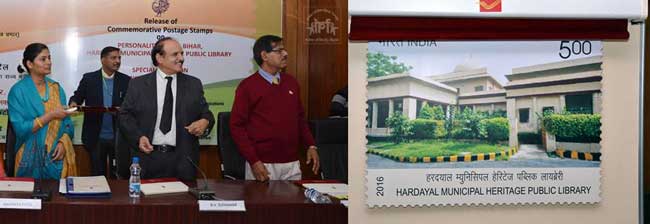
Commemorative Stamps on Personalities of Bihar – 26th December 2016.
Department of Posts released a set of eight commemorative stamps on Dashrath Manjhi, Kailashpati Mishra, Sri Krishna Sinha, Phanishwar Nath 'Renu', Karpoori Thakur, Kunwar Singh, Dr Sachchidananda Sinha, Vidyapati in the denomination of Rs 5 each in Personality Series of Bihar on 26th December, 2016 at a function held at New Delhi. Stamps were released in presence of Anupriya Patel, Minister of State for Health & Family Welfare, Mr. B. V. Sudhakar, Secretary, Department of Posts & Chairperson, Postal Services Board, Shri A. N. Nanda, Member (Banking & HRD) and and Hardayal Municipal Public Library Chairperson Shobha Vijender.
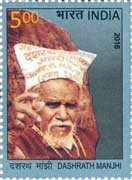
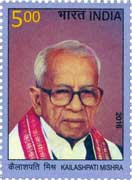 Dashrath Manjhi (c. 1934 – 17 August 2007), also known as Mountain Man, was a poor labourer in Gehlaur village, near Gaya in Bihar, who carved a path 110 m long, 9.1 m wide and 7.6 m deep through a hillock using only a hammer and chisel. After 22 years of work, Dashrath shortened travel between the Atri and Wazirganj blocks of Gaya town from 55 km to 15 km.
Dashrath Manjhi (c. 1934 – 17 August 2007), also known as Mountain Man, was a poor labourer in Gehlaur village, near Gaya in Bihar, who carved a path 110 m long, 9.1 m wide and 7.6 m deep through a hillock using only a hammer and chisel. After 22 years of work, Dashrath shortened travel between the Atri and Wazirganj blocks of Gaya town from 55 km to 15 km.
Kailashpati Mishra (5 October 1923 – 3 November 2012) was a politician. He was leader of the Bharatiya Janta Party and a former Governor of Gujarat and for a short duration Governor of Rajasthan following the death of the incumbent Governor Nirmal Chandra Jain. Kailashpati Mishra was born in Dudharchak, Buxar, Bihar, into a Bhumihar Brahmin family. He was a bachelor and popularly called the "Bhishmapitamah" of Bihar.
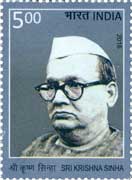 Shri Krishna Sinha (21 October 1887 – 31 January 1961), known as Dr. S. K. Sinha, Sri Babu and Bihar Kesari, was the first Chief Minister of Bihar (1946–61). Except for the period of World War II, Sinha was chief minister of Bihar from the time of the first Congress Ministry in 1937 until his death in 1961. Along with Dr. Rajendra Prasad and Dr. Anugrah Narayan Sinha, Shri Babu is regarded among the Architects of Modern Bihar. He led the Dalit entry into the Baidyanath Dham temple of Deoghar, reflecting his commitment to the upliftment and social empowerment of dalits. He was the first Chief Minister in the country to abolish the zamindari system. He was known as "Bihar Kesari" for his lionlike roars when he rose to address the masses.
Shri Krishna Sinha (21 October 1887 – 31 January 1961), known as Dr. S. K. Sinha, Sri Babu and Bihar Kesari, was the first Chief Minister of Bihar (1946–61). Except for the period of World War II, Sinha was chief minister of Bihar from the time of the first Congress Ministry in 1937 until his death in 1961. Along with Dr. Rajendra Prasad and Dr. Anugrah Narayan Sinha, Shri Babu is regarded among the Architects of Modern Bihar. He led the Dalit entry into the Baidyanath Dham temple of Deoghar, reflecting his commitment to the upliftment and social empowerment of dalits. He was the first Chief Minister in the country to abolish the zamindari system. He was known as "Bihar Kesari" for his lionlike roars when he rose to address the masses.
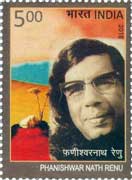 Phanishwar Nath 'Renu' (4 March 1921 – 11 April 1977) was one of the most successful and influential writers of modern Hindi literature in the post-Premchand era. He is the author of Maila Anchal, which after Premchand's Godaan, is regarded as the most significant Hindi novel. Phanishwar Nath 'Renu' is best known for promoting the voice of the contemporary rural India through the genre of 'Aanchalik Upanyas' (Regional Story), and is placed amongst the pioneering Hindi writers who brought regional voices into the mainstream Hindi literature. His short story "Maare Gaye Gulfam" was adapted into a film Teesri Kasam (The Third Vow) by Basu Bhattacharya in 1966 for which he also wrote the dialogues. Later his short story "Panchlight" (Petromax) was made into a TV short film.
Phanishwar Nath 'Renu' (4 March 1921 – 11 April 1977) was one of the most successful and influential writers of modern Hindi literature in the post-Premchand era. He is the author of Maila Anchal, which after Premchand's Godaan, is regarded as the most significant Hindi novel. Phanishwar Nath 'Renu' is best known for promoting the voice of the contemporary rural India through the genre of 'Aanchalik Upanyas' (Regional Story), and is placed amongst the pioneering Hindi writers who brought regional voices into the mainstream Hindi literature. His short story "Maare Gaye Gulfam" was adapted into a film Teesri Kasam (The Third Vow) by Basu Bhattacharya in 1966 for which he also wrote the dialogues. Later his short story "Panchlight" (Petromax) was made into a TV short film.
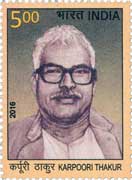
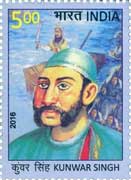 Karpoori Thakur (24 January 1924 – 17 February 1988) was a politician from the Bihar state. He was popularly known as Jan Nayak. He served as the Chief Minister of Bihar from December 1970 to June 1971 (Socialist Party/Bharatiya Kranti Dal), and from December 1977 to April 1979 (Janata Party).
Karpoori Thakur (24 January 1924 – 17 February 1988) was a politician from the Bihar state. He was popularly known as Jan Nayak. He served as the Chief Minister of Bihar from December 1970 to June 1971 (Socialist Party/Bharatiya Kranti Dal), and from December 1977 to April 1979 (Janata Party).
Kunwar Singh (1777 – 26 April 1858) belonged to a royal Ujjainiya Rajput house of Jagdispur, currently a part of Bhojpur district of Bihar. At the age of 80 years, during India's First War of Independence in 1857, he actively led a select band of armed soldiers against the troops under the command of the British East India Company. He was the chief organizer of the fight against the British in Bihar.
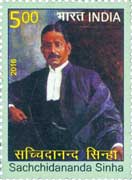 Dr. Sachchidananda Sinha (November 10, 1871- March 6, 1950) was an eminent and noted parliamentarian, educationist, lawyer and journalist of India. He was born in Arrah, in Bihar in a well-to-do Kayastha family. He did his study of Law at London to become a Barrister. He was hardly in his twenties, when he launched the movement for a separate Bihar, soon after returning from England as a barrister in year 1891-92. Away back in 1890 most of the people believed that it was not possible or even desirable. But, a small group of others and he persisted and the dream came true in 1911 when Bihar and Orissa came into existence as a separate province from Bengal at the famous Delhi Durbar.
Dr. Sachchidananda Sinha (November 10, 1871- March 6, 1950) was an eminent and noted parliamentarian, educationist, lawyer and journalist of India. He was born in Arrah, in Bihar in a well-to-do Kayastha family. He did his study of Law at London to become a Barrister. He was hardly in his twenties, when he launched the movement for a separate Bihar, soon after returning from England as a barrister in year 1891-92. Away back in 1890 most of the people believed that it was not possible or even desirable. But, a small group of others and he persisted and the dream came true in 1911 when Bihar and Orissa came into existence as a separate province from Bengal at the famous Delhi Durbar.
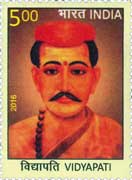 Vidyapati (1352 – 1448), also known by the sobriquet Maithil Kavi Kokil (the poet cuckoo of Maithili) was a Maithili poet and a Sanskrit writer. He was born in the village Bisfi in Madhubani district and died in the Janakpur of Mithila state of Nepal. He was the son of Shri Ganapati Thakur. The name Vidyapati is derived from two Sanskrit words, Vidya (knowledge) and Pati (master), connoting thereby, a man of knowledge. Vidyapati's poetry was widely influential in centuries to come, in the Hindustani as well as Bengali, Maithili, less actively Nepali language and other Eastern literary traditions. Indeed, the language at the time of Vidyapati, the prakrit-derived late abahatta, had just began to transition into early versions of the Eastern languages, Maithili, Nepali, Bengali, Odia, etc. Thus, Vidyapati's influence on making these languages has been described as "analogous to that of Dante in Italy and Chaucer in England."
Vidyapati (1352 – 1448), also known by the sobriquet Maithil Kavi Kokil (the poet cuckoo of Maithili) was a Maithili poet and a Sanskrit writer. He was born in the village Bisfi in Madhubani district and died in the Janakpur of Mithila state of Nepal. He was the son of Shri Ganapati Thakur. The name Vidyapati is derived from two Sanskrit words, Vidya (knowledge) and Pati (master), connoting thereby, a man of knowledge. Vidyapati's poetry was widely influential in centuries to come, in the Hindustani as well as Bengali, Maithili, less actively Nepali language and other Eastern literary traditions. Indeed, the language at the time of Vidyapati, the prakrit-derived late abahatta, had just began to transition into early versions of the Eastern languages, Maithili, Nepali, Bengali, Odia, etc. Thus, Vidyapati's influence on making these languages has been described as "analogous to that of Dante in Italy and Chaucer in England."
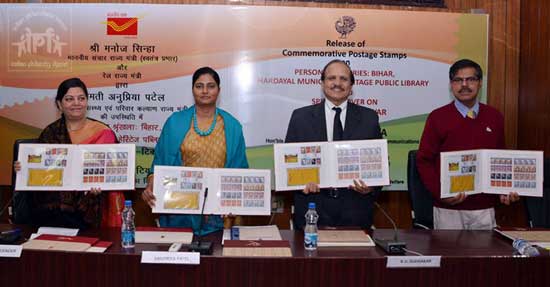
Commemorative Stamp on Season’s Greetings - 23rd December 2016.
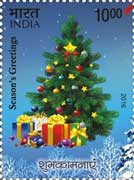
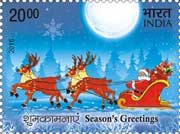 Department of Posts released a set of two stamps in denomination of Rs. 10 and Rs. 20, a Miniature Sheet and two sheetlets on Season’s Greetings on 23rd December, 2016.
Department of Posts released a set of two stamps in denomination of Rs. 10 and Rs. 20, a Miniature Sheet and two sheetlets on Season’s Greetings on 23rd December, 2016.

Commemorative Stamp on Samrat Vikramaditya – 22nd December 2016.
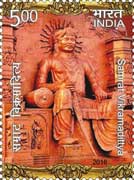 Vikramaditya was a legendary emperor of ancient India. He is characterised as the ideal king, known for his generosity, courage, and patronage of scholars. There are hundreds of legends about Vikramaditya, including the ones in Baital Pachisi and Singhasan Battisi. Most of the legends present him as a universal ruler with his capital at Ujjain (Pataliputra or Pratishthana).
Vikramaditya was a legendary emperor of ancient India. He is characterised as the ideal king, known for his generosity, courage, and patronage of scholars. There are hundreds of legends about Vikramaditya, including the ones in Baital Pachisi and Singhasan Battisi. Most of the legends present him as a universal ruler with his capital at Ujjain (Pataliputra or Pratishthana).
According to the popular tradition, Vikramaditya started the Vikrama Samvat era in 57 BCE, after defeating the Shakas. For this reason, those who believe him to be based on a distinct historical figure place him around the 1st century BCE. However, this era is mentioned as "Vikrama Samvat" only after the 9th century CE. Other scholars argue that Vikramaditya is a mythical character as several of the legends about him are fantastic in nature. "Vikramaditya" was a common title adopted by several Indian kings, and it is possible that the various Vikramaditya legends are embellished accounts of different kings, particularly Chandragupta II.
A commemorative stamp was released on Samrat Vikramaditya by Uttar Pradesh Governor Ram Naik and Union telecom Minister Shri Manoj Sinha at Raj Bhawan, Lucknow on 22nd December 2016.
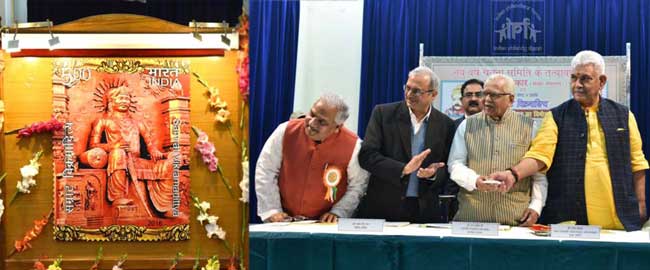

Commemorative Stamp on Acharya Vimal Sagar – 14th December 2016.
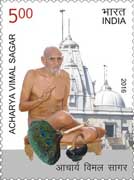 Shri Vimal Sagarji Maharaj is recognized as a Digambar Jain Acharya of the 20th century, known as a Vatsalya Murti and Sant Shiromani for his Tapasya, Riddhi-Siddhi, Scholarship, Gyan, Siddha Bhakti. He was born on 7th day of Ashwin Krishan in 1915 at Kosma in Uttar Pradesh. His real name before taking Deeksha was Nemichand Jain. He took Deeksha on 13th day of Falgun Shukla in 1952. In the year of 1960, he was awarded by “Acharya Pad” from the blessing and permission by Acharya Shri Mahavirkirtiji Maharaj. In 1963 he was awarded a “Charitra Chakraworty Pad” and in 1979 he was awarded Sanmati Divakar Pad”. Acharya Shri Vimal Sagarji took Samadhi on 12th day of Poash Krishna in 1994 at auspicious “Siddha Kshetra Shri Sammedshikharji.
Shri Vimal Sagarji Maharaj is recognized as a Digambar Jain Acharya of the 20th century, known as a Vatsalya Murti and Sant Shiromani for his Tapasya, Riddhi-Siddhi, Scholarship, Gyan, Siddha Bhakti. He was born on 7th day of Ashwin Krishan in 1915 at Kosma in Uttar Pradesh. His real name before taking Deeksha was Nemichand Jain. He took Deeksha on 13th day of Falgun Shukla in 1952. In the year of 1960, he was awarded by “Acharya Pad” from the blessing and permission by Acharya Shri Mahavirkirtiji Maharaj. In 1963 he was awarded a “Charitra Chakraworty Pad” and in 1979 he was awarded Sanmati Divakar Pad”. Acharya Shri Vimal Sagarji took Samadhi on 12th day of Poash Krishna in 1994 at auspicious “Siddha Kshetra Shri Sammedshikharji.
Communication Minister Shri Manoj Sinha released commemorative stamp on Acharya Vimalsagar Ji Maharaj on 14th December 2016 at a function organized at Dak Bhawan, New Delhi.

Collector’s Guide on Special Covers of Tamil Nadu
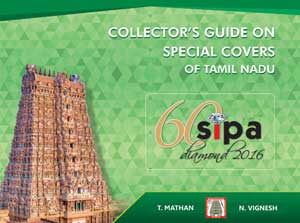 Collector's Guide on Special Covers of Tamil Nadu covering listing of Special Covers issued in the State of Tamil Nadu was released during the SIPA Diamond 2016 Stamp Exhibition. The book is compiled by T. Mathan of Madurai and N. Vignesh of Chennai. Price of the book is Rs. 800. Contact Mr. N. Vignesh (M) +917418711411 , Email: sendmailstovicky@gmail.com for more information.
Collector's Guide on Special Covers of Tamil Nadu covering listing of Special Covers issued in the State of Tamil Nadu was released during the SIPA Diamond 2016 Stamp Exhibition. The book is compiled by T. Mathan of Madurai and N. Vignesh of Chennai. Price of the book is Rs. 800. Contact Mr. N. Vignesh (M) +917418711411 , Email: sendmailstovicky@gmail.com for more information.
Commemorative Stamps on Akshardham Temple, New Delhi and Pramukh Swami Maharaj – 7th December 2016.
Pramukh Swami Maharaj was born in a farmer’s family on 7th December 1921, in the village of Chansad, located near Vadodara. His childhood name was Shantilal. From his childhood, his inclination was to perform spiritual austerities in the Himalayas. However, during his adolescent years, he was attracted to the pure life of Brahmaswarup Shastriji Maharaj, Bhagwan Swaminarayan’s third spiritual successor. After completing his initial studies at the age of 18, he renounced the world and was initiated by Shastriji Maharaj in 1940, and renamed Narayanswarupdas Swami. His striking humility, noble services, saintliness and selfless desire to help all, won him the love of everyone. In 1950, when he was only 28 years old, Shastriji Maharaj appointed him as the president of BAPS. From then on, he affectionately became known as ‘Pramukh Swami’. Yogiji Maharaj declared Pramukh Swami Maharaj to be his spiritual successor and guru of BAPS (Bochasanwasi Akshar Purushottam Sanstha), a role he commenced in 1971.
As a President of BAPS, Pramukh Swami Maharaj had overseen the growth of BAPS from an organization centered in Gujarat, to one spread around the world, maintaining many Hindu Mandirs and centers outside of India. He built more than 1,100 Hindu temples, including the Swaminarayan Akshardham temples in New Delhi and Gandhinagar. He was believed by his followers to be in constant communion with Swaminarayan, and ontologically, the manifestation of Akshar, the eternal abode of Swaminarayan.
Akshardham Temple or Swaminarayan Akshardham complex is a temple, and a spiritual-cultural campus in New Delhi. Akshardham Temple displays millennia of traditional Hindu and Indian culture, spirituality, and architecture. 'Akshardham' means the divine abode of God.
The temple, which attracts approximately 70 percent of all tourists who visit Delhi was constructed by Bochasanwasi Shri Akshar Purushottam Swaminarayan Sanstha (BAPS) and was officially opened on 6th November 2005 by Dr. A.P.J. Abdul Kalam. It sits near the banks of the Yamuna adjacent to the 2010 Commonwealth Games village in eastern New Delhi. The temple, at the centre of the complex, was built according to the Vastu Shastra and Pancharatra shastra. The complex features an Abhisheka Mandap, Sahaj Anand water show, a thematic garden and three exhibitions namely Sahajanand Darshan (Hall of Values), Neelkanth Darshan (an IMAX film on the early life of Swaminarayan as the teenage yogi, Neelkanth), and Sanskruti Darshan (cultural boat ride).
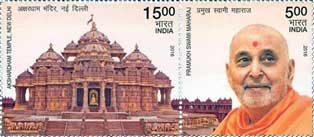 Set of two Commemorative Stamps (Se-tenant pair) on Akshardham Temple, New Delhi and Pramukh Swami Maharaj was released by Shri Amit Shah, President of the Bharatiya Janata Party and Shri Vijay Rupani, Chief Minister of Gujarat in presence of HH Mahant Swami Maharaj on the occasion of Pramukh Swami Maharaj’s 96th Janma Jayanti Mahotsav held at Surat on 7th December 2016.
Set of two Commemorative Stamps (Se-tenant pair) on Akshardham Temple, New Delhi and Pramukh Swami Maharaj was released by Shri Amit Shah, President of the Bharatiya Janata Party and Shri Vijay Rupani, Chief Minister of Gujarat in presence of HH Mahant Swami Maharaj on the occasion of Pramukh Swami Maharaj’s 96th Janma Jayanti Mahotsav held at Surat on 7th December 2016.

Commemorative Stamps on Exotic Birds – 5th December 2016.
Department of Posts issued Commemorative Stamps and Miniature Sheets on Exotic Birds Blue Throated Macaw, Sun Conure, Magnum Amazon, Cape Parrot, Hyacinth Macaw and Lesser Sulphur Crested Cockatoo on 5th December 2016.
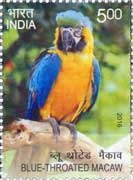 Blue Throated Macaw: The blue-throated macaw (Ara glaucogularis), also known as the Caninde macaw or Wagler's macaw, is a macaw known from the Llanos de Mojos in north Bolivia, being concentrated east of the upper río Mamoré, Beni (Duffield and Hesse 1997, Yamashita and Barros 1997), where the wild population was discovered in 1992. This species is cultural heritage of Bolivia. This species qualifies as Critically Endangered because its population is extremely small and each isolated subpopulation is tiny and declining because of trade and habitat loss. Bas per the IUCN Red list Blue-throated Macaws are protected by trading prohibitions. In 2007 the population was estimated at 250-300 individuals. The population is currently thought to be stable following successful conservation measures and near elimination of trade. The blue-throated macaw is about 85 cm long including the length of its tail feathers and has a wingspan of approximately three feet or 0.9 m. It weighs about 900 g to 1,100 g. Upperparts are turquoise-blue, slightly duller on crown and brighter on rump. Underparts largely bright yellow but the vent is pale blue.
Blue Throated Macaw: The blue-throated macaw (Ara glaucogularis), also known as the Caninde macaw or Wagler's macaw, is a macaw known from the Llanos de Mojos in north Bolivia, being concentrated east of the upper río Mamoré, Beni (Duffield and Hesse 1997, Yamashita and Barros 1997), where the wild population was discovered in 1992. This species is cultural heritage of Bolivia. This species qualifies as Critically Endangered because its population is extremely small and each isolated subpopulation is tiny and declining because of trade and habitat loss. Bas per the IUCN Red list Blue-throated Macaws are protected by trading prohibitions. In 2007 the population was estimated at 250-300 individuals. The population is currently thought to be stable following successful conservation measures and near elimination of trade. The blue-throated macaw is about 85 cm long including the length of its tail feathers and has a wingspan of approximately three feet or 0.9 m. It weighs about 900 g to 1,100 g. Upperparts are turquoise-blue, slightly duller on crown and brighter on rump. Underparts largely bright yellow but the vent is pale blue.
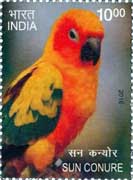 Sun Conure: Sun Conure (Aratinga solstitialis) also known as Yellow Conure or Sun Parakeet is a medium-sized brightly colored parrot native to the north-eastern coastal forests of South America, specifically northeastern Brazil and Guyana. This species is endangered by loss of habitat and trapping for the pet trade. Their numbers are declining, and they are now very scarce or absent across many parts of its former range. However, they are popular and relatively common in the pet trade. Sun conures are now listed as endangered by the IUCN. Sun conures are very social birds, typically living in flocks. They form monogamous pairs for reproduction and nest in palm cavities in the tropics. Sun Conures measure 30 cm in length, including the long tail. They weigh between 100 – 130 g, with an average weight of 110 g. As with all conures, the Sun Conure has the bare, white skin patch around the eyes. The plumage of the sun conure is a strikingly beautiful red/orange/yellow over most of the bird. The wings have a slight green on the wings. The adult male and female are similar in appearance, with predominantly golden-yellow plumage and orange-flushed underparts and face.
Sun Conure: Sun Conure (Aratinga solstitialis) also known as Yellow Conure or Sun Parakeet is a medium-sized brightly colored parrot native to the north-eastern coastal forests of South America, specifically northeastern Brazil and Guyana. This species is endangered by loss of habitat and trapping for the pet trade. Their numbers are declining, and they are now very scarce or absent across many parts of its former range. However, they are popular and relatively common in the pet trade. Sun conures are now listed as endangered by the IUCN. Sun conures are very social birds, typically living in flocks. They form monogamous pairs for reproduction and nest in palm cavities in the tropics. Sun Conures measure 30 cm in length, including the long tail. They weigh between 100 – 130 g, with an average weight of 110 g. As with all conures, the Sun Conure has the bare, white skin patch around the eyes. The plumage of the sun conure is a strikingly beautiful red/orange/yellow over most of the bird. The wings have a slight green on the wings. The adult male and female are similar in appearance, with predominantly golden-yellow plumage and orange-flushed underparts and face.
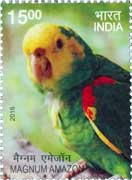 Magnum Amazon: The yellow-headed amazon (Amazona oratrix), also known as the yellow-headed parrot and double yellow-headed amazon, is an endangered amazon parrot of Mexico and northern Central America. It is a stocky short-tailed green parrot with a yellow head. It prefers to live in mangrove forests or forests near rivers or other bodies of water. The yellow-headed amazon averages 38–43 centimeters long. The shape is typical of amazons, with a robust build, rounded wings, and a square tail. The body is bright green, with yellow on the head, dark scallops on the neck, red at the bend of the wing, and yellow thighs. The flight feathers are blackish to bluish violet with a red patch on the outer secondaries. The base of the tail also has a red patch, which is usually hidden. The outer tail feathers have yellowish tips. It is a popular pet and an excellent talker. The variety "Magna Amazon" (or "Magnum Amazon") is bred for more yellow and commands a premium price as a pet.
Magnum Amazon: The yellow-headed amazon (Amazona oratrix), also known as the yellow-headed parrot and double yellow-headed amazon, is an endangered amazon parrot of Mexico and northern Central America. It is a stocky short-tailed green parrot with a yellow head. It prefers to live in mangrove forests or forests near rivers or other bodies of water. The yellow-headed amazon averages 38–43 centimeters long. The shape is typical of amazons, with a robust build, rounded wings, and a square tail. The body is bright green, with yellow on the head, dark scallops on the neck, red at the bend of the wing, and yellow thighs. The flight feathers are blackish to bluish violet with a red patch on the outer secondaries. The base of the tail also has a red patch, which is usually hidden. The outer tail feathers have yellowish tips. It is a popular pet and an excellent talker. The variety "Magna Amazon" (or "Magnum Amazon") is bred for more yellow and commands a premium price as a pet.
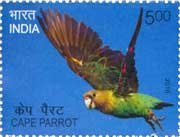 Cape Parrot: The Cape parrot (Poicephalus robustus) or Levaillant's parrot is a temperate forest dwelling Poicephalus parrot endemic to South Africa. It was formerly grouped as a subspecies (along with the savanna-dwelling brown-necked parrot (P. fuscicollis fuscicollis) and grey-headed parrot (P. f. suahelicus)) but is now considered a distinct species. The Cape parrot is a short-tailed moderately large bird with a very large beak used to crack all sorts of hard nuts and fruit kernels, especially those of African yellowwood trees Podocarpus spp.. This contrasts with the closely related savanna species (Poicephalus fuscicollis) which feeds on and a wide variety of tropical woodland trees such as Marula, Commiphora spp. and Terminalia spp. These species are sexually dimorphic, with females typically sporting an orange frontal patch on the forehead. Juveniles also show a larger orange - pink patch on the forehead but lack the red on shoulders and legs of adults. These plumage characteristics vary among individuals and among the three recognized forms.
Cape Parrot: The Cape parrot (Poicephalus robustus) or Levaillant's parrot is a temperate forest dwelling Poicephalus parrot endemic to South Africa. It was formerly grouped as a subspecies (along with the savanna-dwelling brown-necked parrot (P. fuscicollis fuscicollis) and grey-headed parrot (P. f. suahelicus)) but is now considered a distinct species. The Cape parrot is a short-tailed moderately large bird with a very large beak used to crack all sorts of hard nuts and fruit kernels, especially those of African yellowwood trees Podocarpus spp.. This contrasts with the closely related savanna species (Poicephalus fuscicollis) which feeds on and a wide variety of tropical woodland trees such as Marula, Commiphora spp. and Terminalia spp. These species are sexually dimorphic, with females typically sporting an orange frontal patch on the forehead. Juveniles also show a larger orange - pink patch on the forehead but lack the red on shoulders and legs of adults. These plumage characteristics vary among individuals and among the three recognized forms.
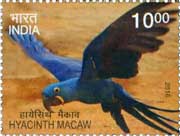 Hyacinth Macaw: The hyacinth macaw (Anodorhynchus hyacinthinus), or hyacinthine macaw, is a parrot native to central and eastern South America. With a length (from the top of its head to the tip of its long pointed tail) of about 100 cm it is longer than any other species of parrot. It is the largest macaw and the largest flying parrot species, though the flightless kakapo of New Zealand can outweigh it at up to 3.5 kg. While generally easily recognized, it can be confused with the far rarer and smaller Lear's macaw. Habitat loss and the trapping of wild birds for the pet trade have taken a heavy toll on their population in the wild, so the species is classified as Vulnerable on the International Union for Conservation of Nature's Red List, and it is protected by its listing on Appendix I of the Convention on International Trade in Endangered Species of Wild Fauna and Flora (CITES).
Hyacinth Macaw: The hyacinth macaw (Anodorhynchus hyacinthinus), or hyacinthine macaw, is a parrot native to central and eastern South America. With a length (from the top of its head to the tip of its long pointed tail) of about 100 cm it is longer than any other species of parrot. It is the largest macaw and the largest flying parrot species, though the flightless kakapo of New Zealand can outweigh it at up to 3.5 kg. While generally easily recognized, it can be confused with the far rarer and smaller Lear's macaw. Habitat loss and the trapping of wild birds for the pet trade have taken a heavy toll on their population in the wild, so the species is classified as Vulnerable on the International Union for Conservation of Nature's Red List, and it is protected by its listing on Appendix I of the Convention on International Trade in Endangered Species of Wild Fauna and Flora (CITES).
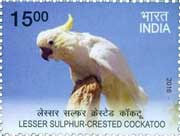 Lesser Sulphur Crested Cockatoo: The yellow-crested cockatoo (Cacatua sulphurea) also known as the lesser sulphur-crested cockatoo, is a medium-sized (approximately 34 cm long) cockatoo with white plumage, bluish-white bare orbital skin, grey feet, a black bill, and a retractile yellow or orange crest. The sexes are similar. The yellow-crested cockatoo is found in wooded and cultivated areas of East Timor and Indonesia's islands of Sulawesi and the Lesser Sundas. It is easily confused with the larger and more common sulphur-crested cockatoo, which has a more easterly distribution and can be distinguished by the lack of pale yellow coloring on its cheeks (although some sulphur-cresteds develop yellowish patches). Also, the yellow-crested cockatoo's crest is a brighter color, closer to orange. The citron-crested cockatoo, which is a subspecies of the yellow-crested cockatoo, is similar, but its crest is clear orange. The yellow-crested cockatoo's diet consists mainly of seeds, buds, fruits, nuts and herbaceous plants.
Lesser Sulphur Crested Cockatoo: The yellow-crested cockatoo (Cacatua sulphurea) also known as the lesser sulphur-crested cockatoo, is a medium-sized (approximately 34 cm long) cockatoo with white plumage, bluish-white bare orbital skin, grey feet, a black bill, and a retractile yellow or orange crest. The sexes are similar. The yellow-crested cockatoo is found in wooded and cultivated areas of East Timor and Indonesia's islands of Sulawesi and the Lesser Sundas. It is easily confused with the larger and more common sulphur-crested cockatoo, which has a more easterly distribution and can be distinguished by the lack of pale yellow coloring on its cheeks (although some sulphur-cresteds develop yellowish patches). Also, the yellow-crested cockatoo's crest is a brighter color, closer to orange. The citron-crested cockatoo, which is a subspecies of the yellow-crested cockatoo, is similar, but its crest is clear orange. The yellow-crested cockatoo's diet consists mainly of seeds, buds, fruits, nuts and herbaceous plants.
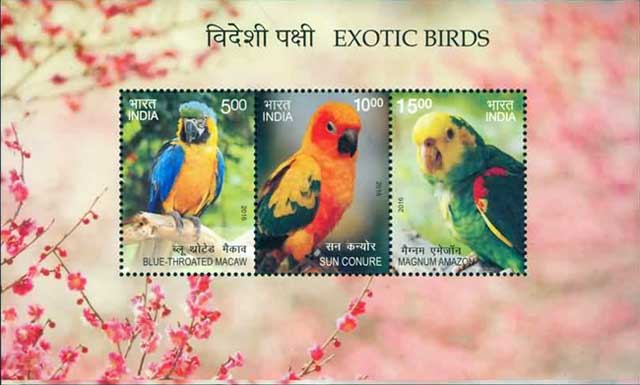
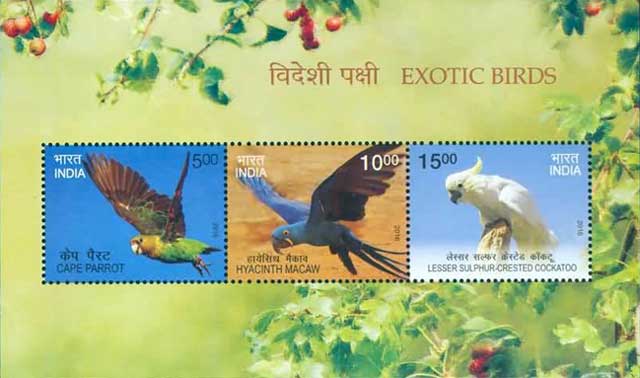
Special Cover on 30th All India Postal Kabaddi Tournament – 2nd December 2016.
Kabaddi is an ancient game played in many parts of India. The mention of the sport dates back to ancient times and is traced in Indian mythology. It is known by its regional names in different parts of the subcontinent, such as Kapaddi or "Chadukudu" in Tamil Nadu, Kabaddi in Karnataka, Telangana, Gujarat, hadudu in Bengal, kauddi in the Punjab region, chedugudu in Andhra Pradesh and bhavatik in Maldives. Kabaddi received international exposure during the 1936 Berlin Olympics, demonstrated by India. The game was introduced in the Indian National Games at Calcutta in 1938. In 1950 the All India Kabaddi Federation (AIKF) came into existence and framed the rules. The AIKF was reconstituted as The Amateur Kabaddi Federation of India (AKFI) in 1972 and the first national tournament for men was held in Chennai. The game was included for the first time in the Asian Games in Beijing in 1990 where seven teams took part.
The Department of Posts conducts All India Postal Kabaddi Tournament every year in different Postal Circles. 30th All India Postal Kabaddi Tournament was held in Bengaluru at Sree Kanteerava Stadium from 29th November to 2nd December for the year 2016 at the behest of the Directorate of the Department of Posts. Kabbadi team of Karnataka Postal Circle won the tournament for four consecutive years from 2009 to 2013 and became runners-up in 2015. On the occasion of 30th All India Postal Kabaddi Tournament a Special Cover was released on 2nd December 2016 at Bengaluru. (Special Cover approval no. KTK/24/2016).
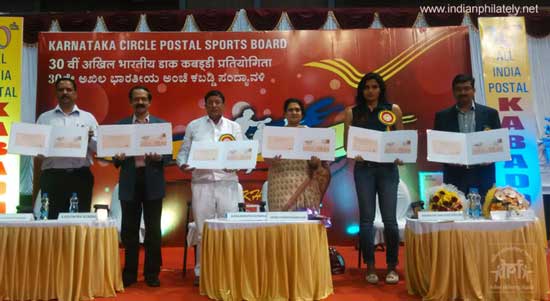
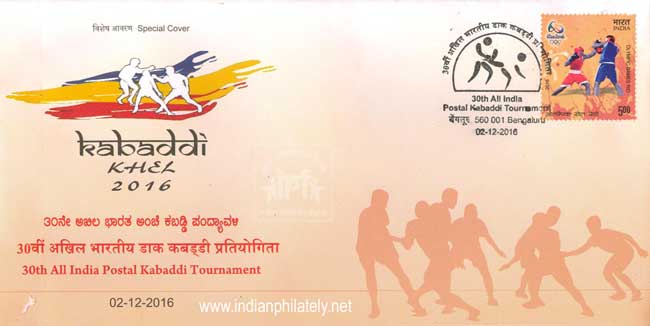
Courtesy: Suresh Rao, Bengaluru
Commemorative Stamp on AIIMS (All-India Institute of Medical Sciences) - 3rd December 2016.
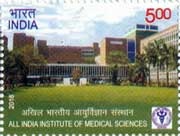 All-India Institute of Medical Sciences (AIIMS) was established in 1956 as an institution of national importance by an Act of Parliament with the objects to develop patterns of teaching in Undergraduate and Post-graduate Medical Education in all its branches so as to demonstrate a high standard of Medical Education in India; to bring together in one place educational facilities of the highest order for the training of personnel in all important branches of health activity; and to attain self-sufficiency in Post-graduate Medical Education. AIIMS is located at Ansari Nagar in Delhi, adjacent to the South Extension-II market, and lies on the south-eastern quadrant of Aurbindo Marg and Inner Ring Road crossing.
All-India Institute of Medical Sciences (AIIMS) was established in 1956 as an institution of national importance by an Act of Parliament with the objects to develop patterns of teaching in Undergraduate and Post-graduate Medical Education in all its branches so as to demonstrate a high standard of Medical Education in India; to bring together in one place educational facilities of the highest order for the training of personnel in all important branches of health activity; and to attain self-sufficiency in Post-graduate Medical Education. AIIMS is located at Ansari Nagar in Delhi, adjacent to the South Extension-II market, and lies on the south-eastern quadrant of Aurbindo Marg and Inner Ring Road crossing.
AIIMS was established in New Delhi after former Indian prime minister Jawaharlal Nehru's initial proposal to set up the institute in Calcutta was turned down by the then Chief Minister of West Bengal Bidhan Chandra Roy. It was the vision of Rajkumari Amrit Kaur, the first Health Minister of India, to establish an institute of such nature in India. The institute's buildings were formally opened by the British monarch on January 27, 1961 at an impressive ceremony attended by the then President Rajendra Prasad. The Institute has comprehensive facilities for teaching, research and patient-care. As provided in the Act, AIIMS conducts teaching programs in medical and para-medical courses both at undergraduate and postgraduate levels and awards its own degrees. Teaching and research are conducted in 42 disciplines. In the field of medical research AIIMS is the lead, having more than 600 research publications by its faculty and researchers in a year. AIIMS also runs a College of Nursing and trains students for B.Sc.(Hons.) Nursing post-certificate) degrees.
As a part of Diamond Jubilee celebration of AIIMS, a Commemorative Stamp was released by The Union Home Minister, Shri Rajnath Singh and MoS for Communications and Railways Shri Manoj Sinha at the 44th Annual Convocation of the AIIMS in New Delhi on 3rd December 2016 in presence of Shri Jagat Prakash Nadda Union Minister of Health and Family Welfare and other dignitaries.
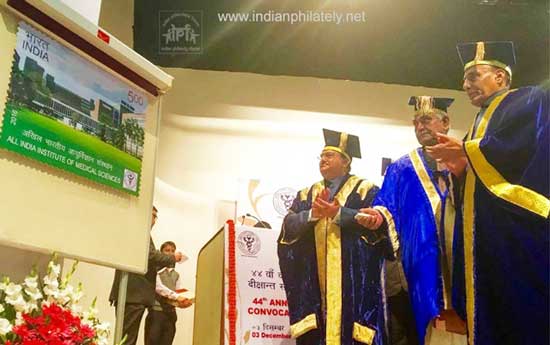
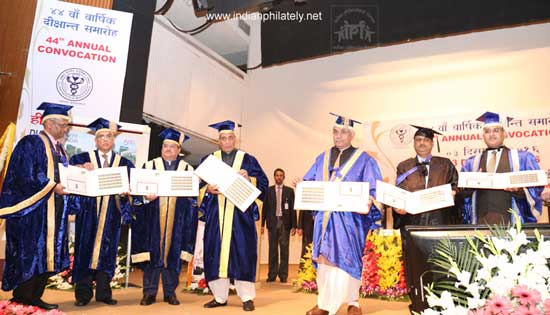
Special Cover on Mithun - 1st December 2016.
Arunachalpex-2016, a district level philatelic exhibition was held at Itanagar on 1st and 2nd December 2016. On the occasion a Special Cover on Mithun, the State animal of Arunachal Pradesh was released on 1st December 2016. (Special Cover approval no. NE/12/2016-17).
Mithun, also known as ‘Cattle of Mountain” is an important bovine species of north-eastern hill region of India and of China, Myanmar, Bhutan and Bangladesh. This magnificent massive bovine is presently reared under free-range condition in the hill forests at an altitude of 1000 to 3000 m above mean sea level. The scientific name of the Mithun is Bos Frontalis. Mithuns are wild and each family has a very indigenous marking as a cut on the ear. Mithun is the State animal of Arunachal Pradesh. The skin colour of the Mithun is Black-brownish in both sexes and the portion of the limbs are white or yellowish. It plays a special role in both religious and social life of the people of Arunachal Pradesh. To the Idu-Mishmi, Nyishi, Tagin or Adi-Galo (Bangni-Bokar, Lhobas including Pasi, Padam, Minyong, Galo), the possession of Mithun is the traditional measure of a family’s wealth. Mithun are not milked or put to work but given supplementary care while grazing in the woods, until they are ritually slaughtered or killed for local consumption.
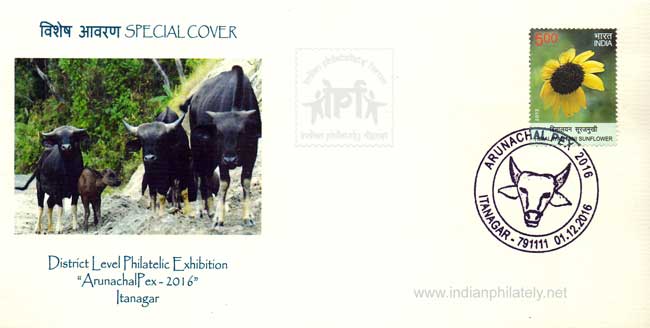
Courtesy: Joy Justin Bongcher, Shillong


